Intel Core i7 3820 Review: $285 Quad-Core Sandy Bridge E
by Anand Lal Shimpi on December 29, 2011 2:28 AM EST- Posted in
- CPUs
- Intel
- Sandy Bridge
- Sandy Bridge E
If you are a normal desktop user or even a power user with plans to run at over 4GHz, the vanilla LGA-1155 Sandy Bridge platform is good enough. You get some of the fastest CPUs on the market today paired with reasonably priced motherboards and the ability to use Quick Sync to transcode video...er...quickly. If that's not enough, Intel launched a higher end platform last month: the LGA-2011 Sandy Bridge E.
Take a regular Sandy Bridge, add PCIe 3.0 support, increase the number of PCIe lanes that branch off of the CPU (from 16 to 40 lanes), double the number of memory channels (4 x 64-bit DDR3 memory controllers) and you've got Sandy Bridge E and its LGA-2011/X79 platform. SNB-E is currently available in two forms: a $999 6-core Extreme Edition part (Core i7 3960X) and a $555 6-core unlocked version (Core i7 3930K). Neither is exactly cheap but if you need the PCIe lanes, core count and memory bandwidth, they are your only ticket.
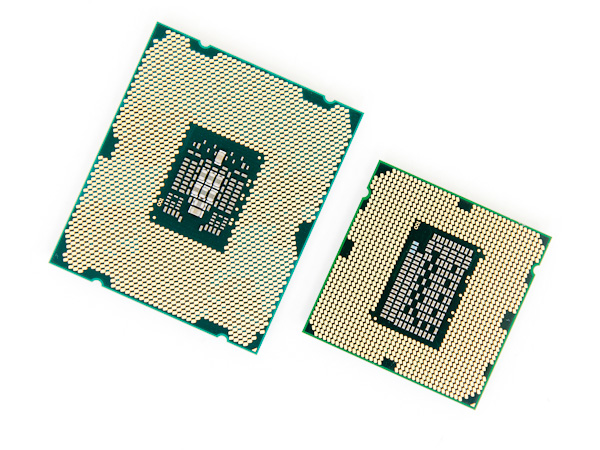
LGA-2011 SNB-E (left) vs. LGA-1155 SNB (right)
Sandy Bridge E is a fairly niche platform to begin with, but what about the niche within the niche (extremeception?) of users who just need the LGA-2011 platform but not necessarily a 6-core behemoth? For those users, there's the Core i7 3820:
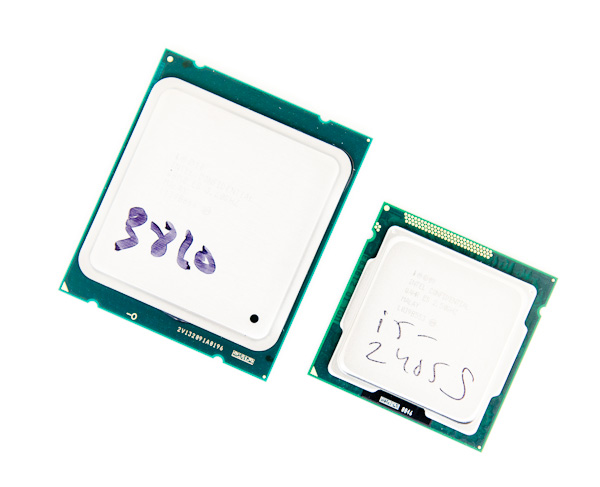
LGA-2011 SNB-E (left) vs. LGA-1155 SNB (right)
The Core i7 3820 is the first (and only) quad-core Sandy Bridge E CPU. It's so new that the chip isn't even available for sale nor will it be until early 2012. Unlike the relationship between the 3960X and 3930K, the 3820 is an entirely new die.
The chip features four Sandy Bridge cores and is paired with a 10MB L3 cache, giving it a slight advantage over the highest end LGA-1155 Sandy Bridge CPUs on the market today. The result is a die that's bigger than a regular SNB but significantly smaller than a 6-core SNB-E:
| CPU Specification Comparison | ||||||||
| CPU | Manufacturing Process | Cores | Transistor Count | Die Size | ||||
| AMD Bulldozer 8C | 32nm | 8 | 1.2B | 315mm2 | ||||
| AMD Thuban 6C | 45nm | 6 | 904M | 346mm2 | ||||
| AMD Deneb 4C | 45nm | 4 | 758M | 258mm2 | ||||
| Intel Gulftown 6C | 32nm | 6 | 1.17B | 240mm2 | ||||
| Intel Sandy Bridge E (6C) | 32nm | 6 | 2.27B | 435mm2 | ||||
| Intel Sandy Bridge E (4C) | 32nm | 4 | 1.27B | 294mm2 | ||||
| Intel Nehalem/Bloomfield 4C | 45nm | 4 | 731M | 263mm2 | ||||
| Intel Sandy Bridge 4C | 32nm | 4 | 995M | 216mm2 | ||||
| Intel Lynnfield 4C | 45nm | 4 | 774M | 296mm2 | ||||
| Intel Clarkdale 2C | 32nm | 2 | 384M | 81mm2 | ||||
| Intel Sandy Bridge 2C (GT1) | 32nm | 2 | 504M | 131mm2 | ||||
| Intel Sandy Bridge 2C (GT2) | 32nm | 2 | 624M | 149mm2 | ||||
There's a small improvement in base clock frequency over the fastest SNB (3.6GHz vs. 3.5GHz) but max turbo remains unchanged at 3.9GHz. For single threaded applications the 3820 should be just as fast as a Core i7 2700K or a 3960X. The same is true for if all heavily threaded workloads, at least when compared to other quad-core parts (the 3960/3930 still maintain an advantage because of their two additional cores).
| Processor | Core Clock | Cores / Threads | L3 Cache | Max Turbo | Max Overclock Multiplier | TDP | Price |
| Intel Core i7 3960X | 3.3GHz | 6 / 12 | 15MB | 3.9GHz | 57x | 130W | $990 |
| Intel Core i7 3930K | 3.2GHz | 6 / 12 | 12MB | 3.8GHz | 57x | 130W | $555 |
| Intel Core i7 3820 | 3.6GHz | 4 / 8 | 10MB | 3.9GHz | 43x | 130W | $285 |
| Intel Core i7 2700K | 3.5GHz | 4 / 8 | 8MB | 3.9GHz | 57x | 95W | $332 |
| Intel Core i7 2600K | 3.4GHz | 4 / 8 | 8MB | 3.8GHz | 57x | 95W | $317 |
| Intel Core i7 2600 | 3.4GHz | 4 / 8 | 8MB | 3.8GHz | 42x | 95W | $294 |
| Intel Core i5 2500K | 3.3GHz | 4 / 4 | 6MB | 3.7GHz | 57x | 95W | $216 |
| Intel Core i5 2500 | 3.3GHz | 4 / 4 | 6MB | 3.7GHz | 41x | 95W | $205 |
There's no on-die GPU, no heatsink/fan in the box and this isn't a fully unlocked part so the 3820 is actually cheaper than most of the high-end Sandy Bridge CPUs: it's priced at $285. If it weren't for the fact that you'll still need to spend over $200 on a motherboard I would say that the 3820 is a steal.
Overclocking
Let's start with the basics. All Sandy Bridge CPUs are clock locked by default, they can't operate at frequencies other than what they're sold at. There are two exceptions to this rule. All Sandy Bridge CPUs that support Turbo Boost are partially unlocked. Not only can they turbo up to frequencies that are higher than their default clock, but they can also be overclocked to frequencies even higher than their turbo speeds. By default, all Turbo enabled Sandy Bridge CPUs can be set to run at up to four bins (4 * bclk or 400MHz by default) higher than their standard turbo frequencies:
The second exception is any of the K or X-series SKUs. If your Sandy Bridge model number ends in a K or X, then the chip is fully unlocked and can be overclocked up to 5.7GHz using only clock multiplier adjustments.
The Core i7 3960X and 3930K fall into the latter category, which makes overclocking them a breeze. The 3820 on the other hand is partially unlocked, which means that we can run it at up to 4.3GHz using multiplier adjustments alone. Note that the 4.3GHz limit only applies to the 1-core active state, in the worst case scenario of all cores active with no room to turbo the highest operating frequency of the chip when overclocked would be 4.0GHz.
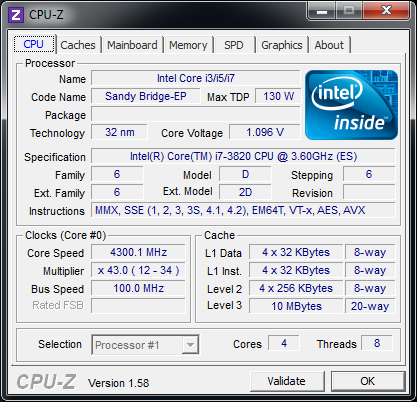
The max 3820 overclock without touching bclk settings
While these aren't bad targets, they're not all that exciting either. Thankfully Sandy Bridge E makes it even easier to overclock through the use of a few higher bclk frequencies. By default Sandy Bridge uses a 100MHz bclk, but SNB-E allows for 125MHz, 166MHz and 250MHz options as well. The 166/250MHz settings are a bit too aggressive, but the 125MHz bclk setting proved to be the perfect companion for the 3820.
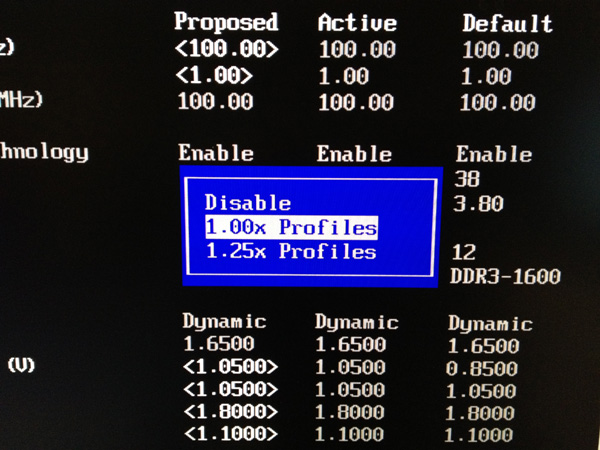
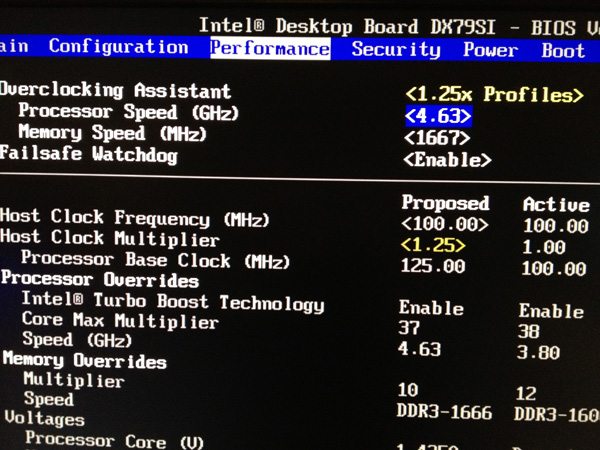
Intel's DX79SI makes it extremely easy to overclock, especially with the latest BIOS update. There are built in overclocking profiles for each bclk setting that you can choose from. I simply selected the 1.25x (125MHz) profile option and then went through the list of target frequencies until I found one that seemed promising. I also went in and tweaked some of the settings myself to get a bit more clock speed (4.63GHz is the fastest profile this board allows by default) and improve stability. In the end I was fairly pleased with what the 3820 could do: 4.75GHz with Intel's RTS2011LC closed loop cooling system.
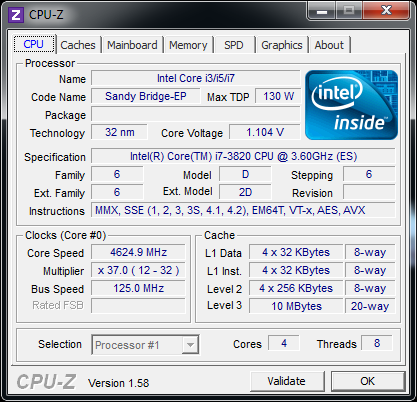
Now we're talking
I couldn't get the 3820 as stable as I would like at 4.88GHz and 5GHz was unfortunately out of the reach of my sample. I can't really complain about 4.75GHz from a $285 chip though, especially without resorting to anything too exotic from a cooling standpoint. Overclocking is also extremely effortless thanks to the new bclk options on SNB-E. Although the Core i7 3820 isn't an unlocked part, that doesn't limit how far (or how easily) it can be overclocked. A big part of the ease of overclocking is due to how good of a job Intel did on the DX79SI BIOS options, but from what we've seen the third party boards also do a decent job of simplifying the process.
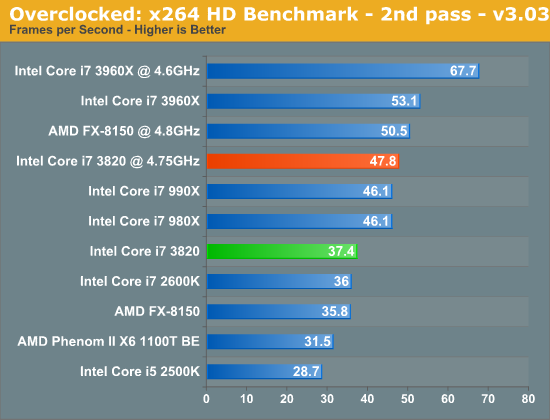
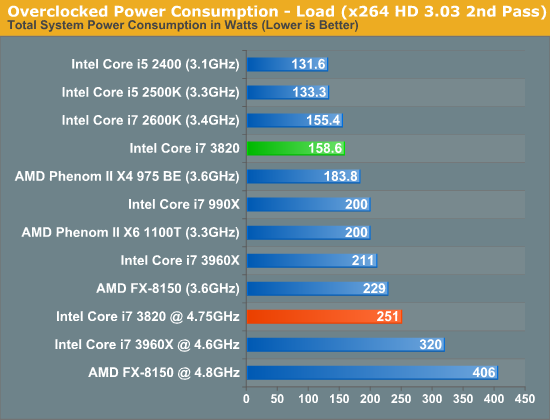
The Test
To keep the review length manageable we're presenting a subset of our results here. For all benchmark results and even more comparisons be sure to use our performance comparison tool: Bench.
| Motherboard: |
ASUS P8Z68-V Pro (Intel Z68) ASUS Crosshair V Formula (AMD 990FX) Intel DX79SI (Intel X79) |
| Hard Disk: |
Intel X25-M SSD (80GB) Crucial RealSSD C300 |
| Memory: | 4 x 4GB G.Skill Ripjaws X DDR3-1600 9-9-9-20 |
| Video Card: | ATI Radeon HD 5870 (Windows 7) |
| Video Drivers: | AMD Catalyst 11.10 Beta (Windows 7) |
| Desktop Resolution: | 1920 x 1200 |
| OS: | Windows 7 x64 |


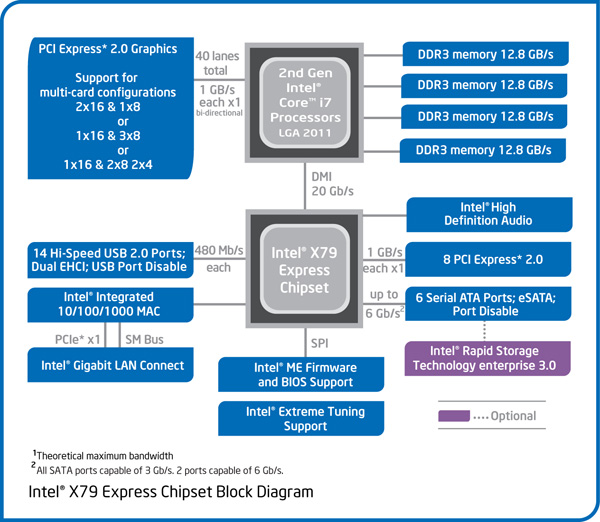









84 Comments
View All Comments
Tetracycloide - Thursday, December 29, 2011 - link
I like the way you think.vectorm12 - Thursday, December 29, 2011 - link
I doubt the extra PCI-e lanes have a tangible real-world benefit when gaming to be honest.However if you use the cards mainly for compute I in no way doubt there's potential for a massive performance increase to be had as shown by the 7970 review.
All in all I consider SNB-E to be a gigantic letdown as it really doesn't cater to enthusiasts as much as to workstation users.
Considering the cost of the platform I doubt one of the lower tier XEON platforms wouldn't be more cost-efficient in the long run, considering ECC RAM etc.
thunderising - Thursday, December 29, 2011 - link
Was expecting more improvements from this TOCK of Intel'spiroroadkill - Thursday, December 29, 2011 - link
Ivy Bridge is right round the corner. Is anyone really buying a new system at the moment?piroroadkill - Thursday, December 29, 2011 - link
Obviously there's a place at the very high end for the 6-core part, but a 4-core part at this level is pointless. Anyone who wanted a system of this performance already bought a 2500 or 2600K and overclocked the balls off it, so for those people, nothing less than Ivy Bridge or beyond will do.Beats me.
AssBall - Thursday, December 29, 2011 - link
Well... This chip might get really interesting once we get the pricing numbers for Ivy Bridge. It is a solid chip I would consider if equivalent Ivy Bridge is priced high. I don't see any reason for Intel not to price Ivy Bridge highly either. They can compete with AMD on their lower end parts.Denithor - Thursday, December 29, 2011 - link
Anyone who needs large amounts of RAM without the cost of 8GB sticks would be happy with this option. 8x4GB is much much cheaper than 4x8GB...Roland00Address - Thursday, December 29, 2011 - link
4gb sticks of ddr3 memory is about $3 to $4 dollars per gb8gb sticks of ddr3 memory is about $9 dollars per gb. These stick prices have gone down in price recently to much more reasonable levels.
Denithor - Thursday, December 29, 2011 - link
Well, even at that rate it's still a considerable savings:8x 4GB x $4/GB = $128
4x 8GB x $9/GB = $288
For a net savings of ~$160. Which, combined with the lower price on the chip, would completely offset the increased cost of the motherboard.
Plus, if 32GB just isn't enough, you could go 8x8GB which you simply cannot do on SB/IB setups (only ship with 4 physical RAM slots).
14ccKemiskt - Thursday, December 29, 2011 - link
Well spoken!